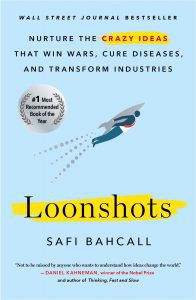
Loonshots is a book that aims to change the perspective of its readers and broaden the way see and interpret ideas. The author, Safi Bahcall, shares lessons learned from various real-life events in history like wartime, birth control, the first polaroid camera and space exploration to name a few.
What are loonshots?
- According to the author, loonshots are a “neglected project, widely dismissed, its champion written off as unhinged.”
- Loonshots are extremely risky as they are based on ideas that are conventionally considered unfeasible by experts.
- The radar system was actually rejected by the military chiefs and bureaucrats on several accounts. If this technology was not neglected in this manner, the military could have saved several lives, ships, planes and battles.
- There are 2 types of loonshots: The P-type and the S-type.
- P-type is a breakthrough in a product and the S-type is a breakthrough in strategy.
Organization Phases:
- The author argues that an organizations ability to recognize and nurture loonshots depends on the phase of the organization.
- As an organization grows, it develops a more and more complex system. Some organizations are in a phase that cannot focus on loonshots but something else.
- Organization complexity grows with its size. The larger the organization, the more slow-moving it becomes reducing its ability to stay agile and harness the potential of loonshots.
A franchise is different from loonshots:
- There are two phases of an idea. One is the loonshot phase which then later transitions into the franchise phase.
- Loonshot phase is when the actual breakthrough was discovered while the franchise phase is when these breakthroughs developed for multiple uses and different versions.
- The author uses the latest iPhone and a new James Bond movie as examples where the products are newer versions of an existing product.
# Key Takeaways:
– The importance of nurturing “loonshots,” or crazy ideas, in order to drive innovation and success in a company.
– The concept of “phase transitions,” where small changes can lead to big shifts in behavior and outcomes.
– The need for a balance between “artists” and “soldiers” in an organization, with artists being the creative thinkers and soldiers being the implementers.
– The role of psychological safety in fostering a culture of innovation and risk-taking.
– The importance of creating a separate team or division to focus on loonshots, rather than trying to integrate them into the existing structure.
# Practical Application:
– Encourage and support employees to share their crazy ideas, even if they seem far-fetched or unconventional.
– Create a safe and open environment for brainstorming and experimentation.
– Foster a culture of learning from failures and taking calculated risks.
– Consider implementing a separate team or division to focus solely on loonshots, with its own budget and resources.
– Continuously monitor and adapt to changes in the market and industry to identify potential phase transitions.
# Valuable Insights for Leaders:
– Chapter 3: “The Moses Trap”
– highlights the dangers of clinging to past successes and not being open to new ideas.
– Chapter 5: “The Magic Number”
– discusses the importance of team size and structure in fostering innovation.
– Chapter 7: “The Cold War”
– explores the role of competition and collaboration in driving innovation.
– Chapter 9: “The Biology of Innovation”
– delves into the science behind creativity and how to nurture it in an organization.
# Case Studies and Examples:
– The development of the first digital camera by Kodak, and how their failure to embrace this loonshot ultimately led to their downfall.
– The success of Pixar and their approach to nurturing loonshots through their “Braintrust” meetings.
– The story of how the US Navy transformed their culture to embrace loonshots and become a more innovative organization.
– The development of the first cancer immunotherapy drug by a small team at Bristol-Myers Squibb, and how their success was driven by a culture of risk-taking and experimentation.
Leave a Reply